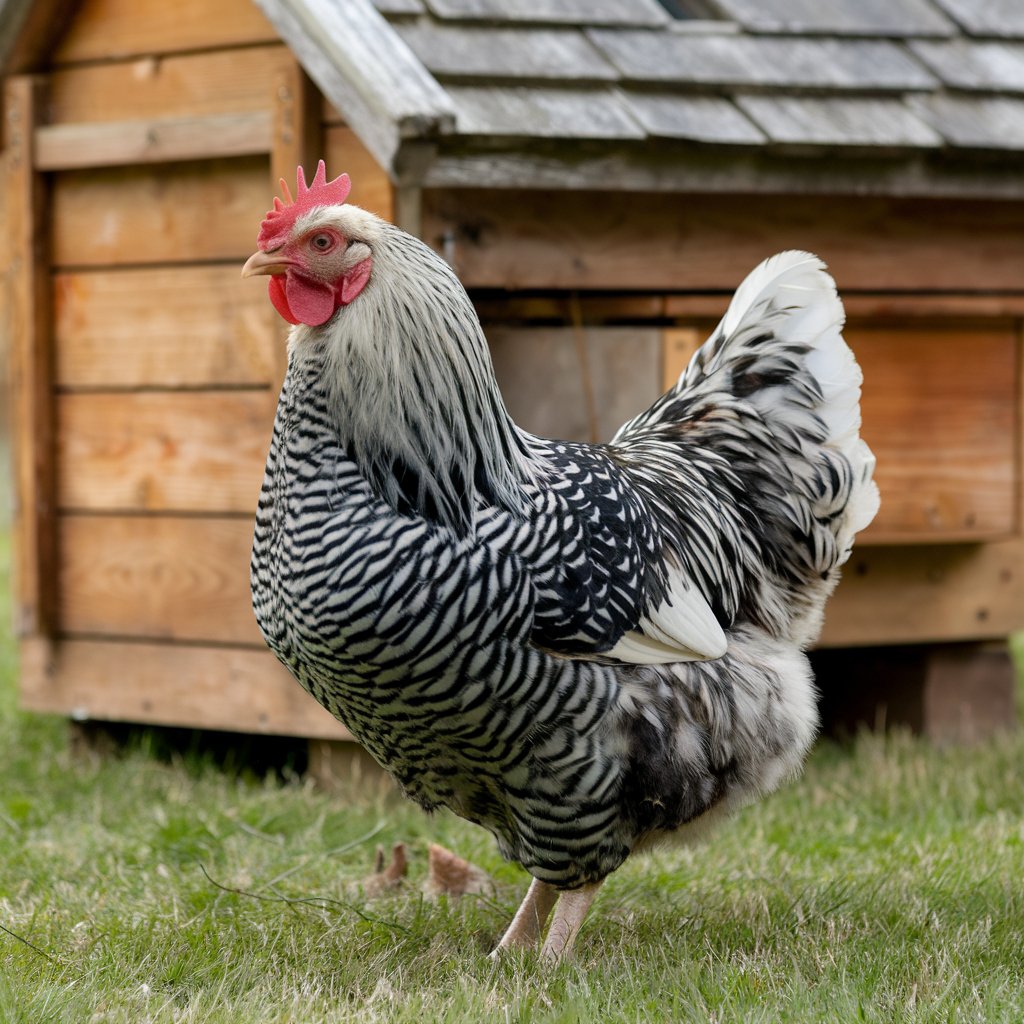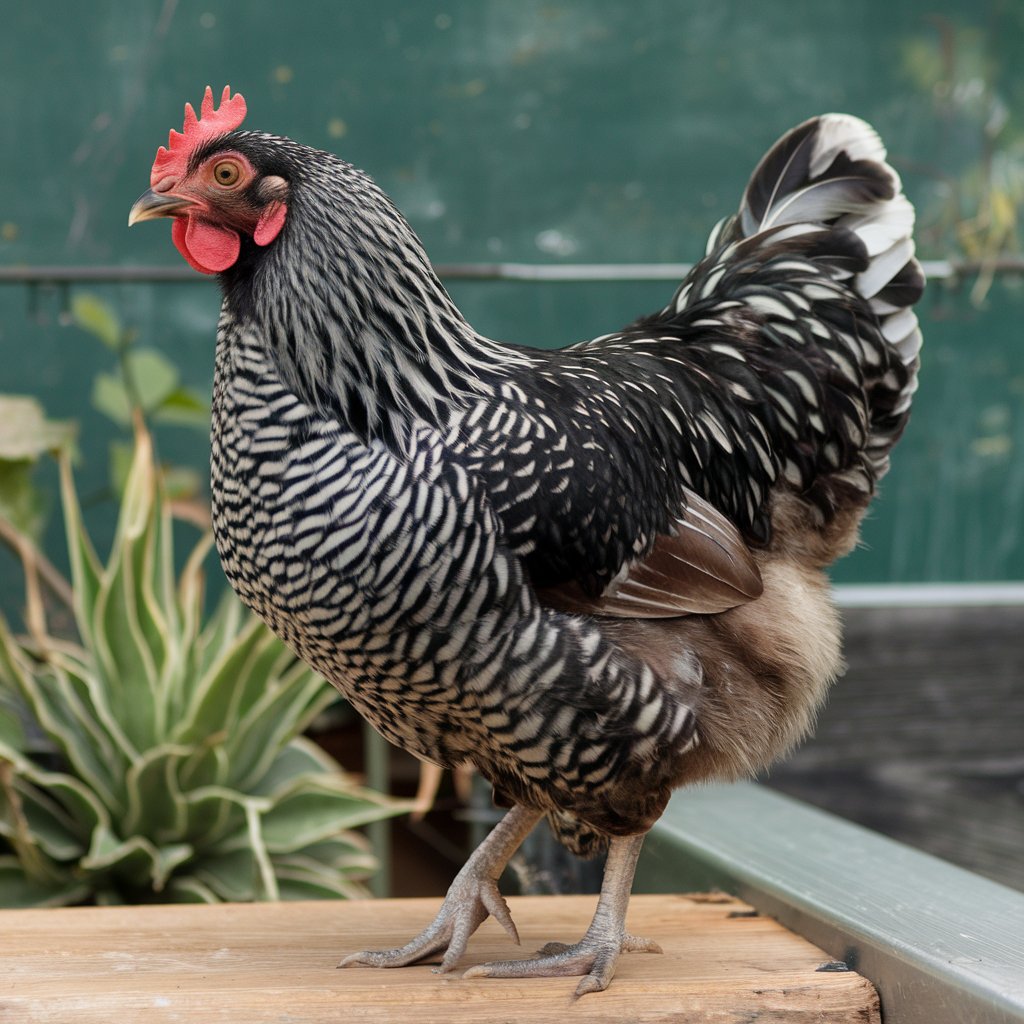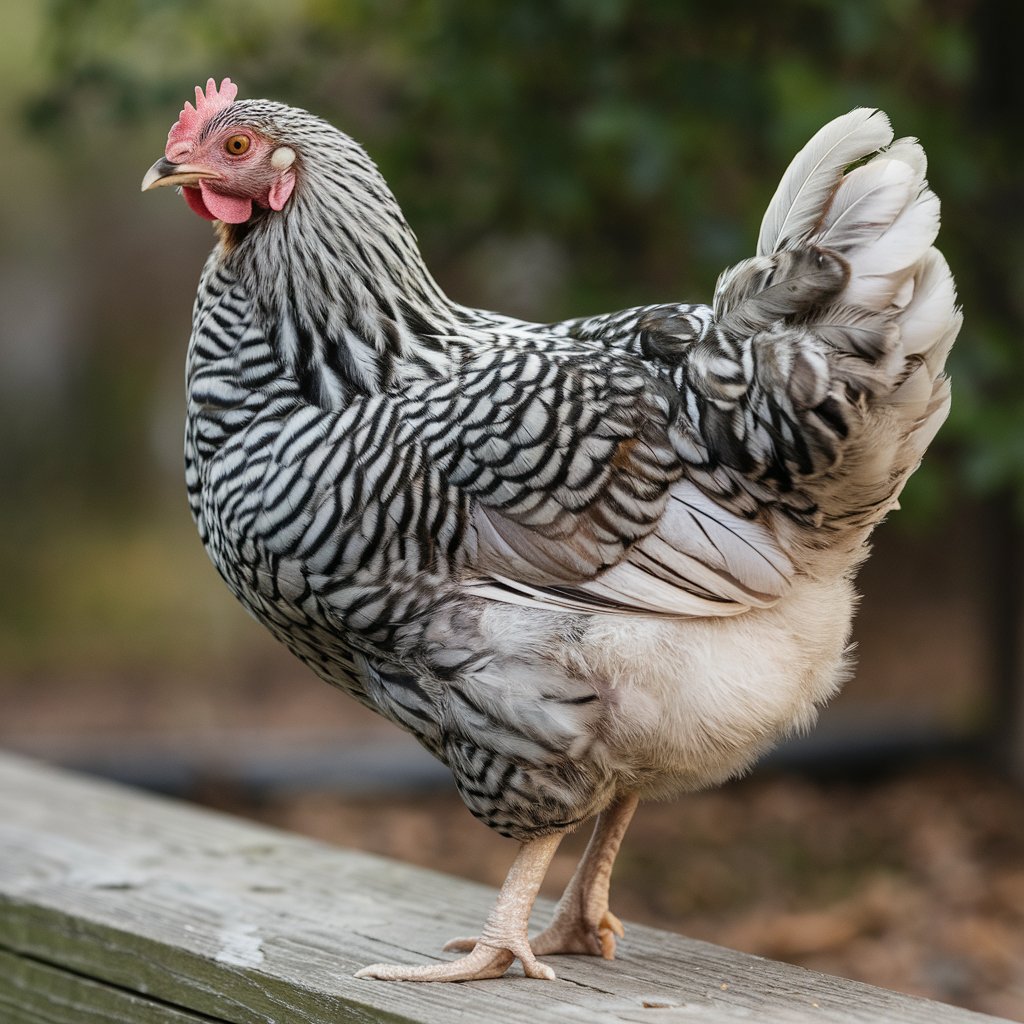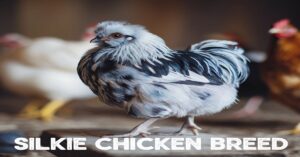The Plymouth Barred Rock chicken is one of the most popular and enduring breeds in the poultry world. With its distinctive black and white barred feathers, friendly personality, and reputation as a reliable dual-purpose bird, this breed is a favorite among both backyard chicken keepers and farmers. If you’re looking for a hardy chicken that consistently produces eggs and doubles as a quality meat source, the Barred Rock chicken might be the perfect choice.
This guide explores everything you need to know about the Plymouth Barred Rock chicken—its history, physical traits, temperament, egg production, and care requirements—helping you decide if it’s the right addition to your flock.
Here’s a comprehensive table with facts and figures about the Plymouth Barred Rock chicken for quick reference:
| Category | Details |
|---|---|
| Breed Name | Plymouth Barred Rock Chicken |
| Type | Heritage, Dual-purpose (Eggs & Meat) |
| Origin | Massachusetts, USA (1869) |
| Weight | Roosters: 9.5 lbs; Hens: 7.5 lbs; Cockerels: 8 lbs; Pullets: 6–7 lbs |
| Egg Production | 4–5 eggs per week; ~200 eggs per year |
| Egg Color | Light to medium brown |
| Egg Size | Large |
| Lifespan | 6–8 years (up to 10–12 years with optimal care) |
| Temperament | Docile, friendly, curious, non-aggressive |
| Feather Pattern | Black and white barred feathers |
| Comb Type | Single, large comb |
| Wattles and Earlobes | Bright red |
| Legs | Yellow, clean (no feathering) |
| Hardiness | Cold hardy; tolerates heat with proper care |
| Broodiness | Occasionally broody, good mothers when they hatch chicks |
| Housing Requirements | 4 sq. ft. per bird in the coop; 10 sq. ft. per bird in the run |
| Special Features | Continues laying during winter, adaptable to free-ranging or confined setups |
| Meat Quality | Rich flavor, more dark meat than Cornish Cross |
| Common Health Issues | Mites, lice, frostbite, heat stress |
| Best Use | Beginner-friendly breed for families, egg-laying, and sustainable meat production |
| Recognition | Recognized by the American Poultry Association in 1874 |
Breed History and Origins
The Plymouth Rock chicken was first developed in Massachusetts in 1869 and is considered one of the earliest American breeds. It gained widespread popularity during the 19th and early 20th centuries due to its practicality, making it a staple in many small farms and homesteads.

Key Points About the Breed’s History:
- Origins: Created by crossing Dominique chickens (known for their barred feather pattern) with other breeds like Black Javas and possibly Cochins.
- American Poultry Association (APA) Recognition: The Barred Rock variety was officially recognized in 1874, making it one of the oldest APA-standardized breeds.
- Historical Role: During World War II, Barred Rock chickens were a common sight in backyard Victory Gardens, as they provided families with both eggs and meat.
This heritage breed is a cornerstone of American poultry farming and remains a popular choice for sustainable, small-scale agriculture.
Barred Rock vs. Plymouth Rock: What’s the Difference?
A common question among chicken enthusiasts is whether Barred Rock chickens and Plymouth Rock chickens are the same. While related, there’s a subtle distinction:
- Plymouth Rock refers to the overall breed, which includes multiple color varieties.
- Barred Rock is a specific variety within the Plymouth Rock breed, identifiable by its black and white barred feather pattern.
Plymouth Rock Varieties
| Variety | Description |
|---|---|
| Barred | Black and white barred feathers (most common). |
| White | Solid white plumage, popular for meat production. |
| Buff | Golden-yellow feathers with a warm hue. |
| Silver Penciled | Black and silver intricate patterns. |
| Partridge | Reddish-brown with dark penciling. |
| Columbian | White with black accents on the neck and tail. |
The Barred Rock remains the most iconic and widely recognized variety, but all Plymouth Rock chickens share the same docile temperament and dual-purpose functionality.
Heritage or Hybrid Breed?
The Barred Rock chicken is a classic heritage breed, meaning it has been bred naturally for generations without genetic modification.
Traits of Heritage Breeds:
- Reproductive Ability: Unlike hybrid breeds, heritage chickens can reproduce naturally, allowing for sustainable farming practices.
- Hardiness: Retains natural survival traits, such as resistance to cold weather and strong immune systems.
- Longevity: Heritage breeds, including the Barred Rock, typically have a longer productive lifespan.
In contrast, modern hybrid chickens like Golden Comets or Cornish Cross are bred for specific traits (e.g., rapid growth or high egg production) but often lack the hardiness and sustainability of heritage breeds.
Physical Appearance and Traits
The Barred Rock chicken is a medium to large-sized bird with a robust, well-proportioned frame. Its distinctive appearance makes it easy to identify.
Physical Characteristics:
- Feather Pattern: Alternating black and white bars give it a striking, zebra-like appearance. Each feather features an even distribution of color.
- Comb and Wattles: The single comb is upright and bright red, as are the wattles and earlobes.
- Eyes: Expressive and alert, often a rich orange or red color.
- Legs: Clean and yellow, with no feathering.
- Beak: Yellow and slightly curved.
This eye-catching appearance isn’t just aesthetic; it reflects the Barred Rock’s hardiness and adaptability, qualities bred into the bird over centuries.

Size and Weight
The Barred Rock chicken is classified as a large breed, making it ideal for both egg and meat production.
Average Weight Chart:
| Gender | Weight |
|---|---|
| Rooster | 9.5 pounds |
| Hen | 7.5 pounds |
| Cockerel | 8 pounds |
| Pullet | 6–7 pounds |
Their sturdy build makes them efficient foragers and productive birds on a homestead.
Lifespan and Longevity
The Barred Rock chicken has an average lifespan of 6–8 years, although well-cared-for individuals can live up to 10–12 years.
Tips for Extending Lifespan:
- Diet: Feed them a balanced diet rich in protein, calcium, and vitamins.
- Housing: Keep their living conditions clean and predator-proof.
- Preventive Care: Regularly check for common health issues like parasites or infections.
With proper care, Barred Rocks can remain healthy and productive for most of their lives.
Egg Production
One of the biggest draws of the Plymouth Barred Rock chicken is its reliable egg production.
Egg Production Details:
- Yield: Produces around 4–5 eggs per week, or approximately 200 eggs per year.
- Egg Color: Light to medium brown, with a smooth and durable shell.
- Egg Size: Large, making them ideal for cooking and baking.
- Winter Laying: Barred Rocks often continue laying during colder months, unlike many other breeds.
For small farms and backyard setups, this consistent egg production makes the Barred Rock chicken an invaluable addition.
Breeding and Broodiness
While Barred Rock hens are not overly broody, they occasionally display strong maternal instincts, making them good choices for natural hatching.
Tips for Successful Breeding:
- Pair hens with a healthy rooster to ensure fertility.
- Provide a quiet, safe nesting area to encourage broodiness.
- Maintain a balanced flock with 1 rooster per 8–10 hens to prevent stress.
Hens that do go broody are attentive mothers, often raising strong and healthy chicks.
Hardiness and Adaptability
The Barred Rock chicken is one of the hardiest and most adaptable breeds available. It thrives in a variety of climates and conditions, making it a favorite for farmers worldwide.
Weather Adaptability:
- Cold Hardy: Their dense plumage provides excellent insulation, protecting them from frostbite and cold temperatures.
- Heat Tolerant: While they handle heat better than some breeds, they still require shade and access to fresh water in hot weather.
This breed’s adaptability makes it suitable for regions with fluctuating temperatures or extreme weather.

Common Health Concerns
While generally hardy, Barred Rocks are not immune to certain health challenges.
Common Issues:
- Parasites: External parasites like mites and lice can infest their feathers and skin.
- Frostbite: Prevent frostbite on combs during cold winters by applying petroleum jelly.
- Heat Stress: Provide shade and plenty of water to avoid overheating in summer.
Preventive Care Checklist:
- Regularly inspect feathers, skin, and droppings for signs of illness.
- Add supplements like apple cider vinegar to water for an immune boost.
- Keep their coop clean and well-ventilated to prevent respiratory issues.
Meat Production
The Barred Rock chicken is a high-quality source of meat, making it a true dual-purpose bird.
Meat Characteristics:
- Flavor: Rich and slightly gamey, with more dark meat than hybrid breeds.
- Texture: Firm but tender, making it excellent for roasting or stewing.
- Processing Age: Best harvested between 16–20 weeks for optimal tenderness.
If you’re looking for a sustainable meat source, Barred Rocks are an excellent choice for small-scale production.
Temperament and Behavior
One of the breed’s most endearing traits is its friendly and curious temperament.
Key Behavioral Traits:
- Docile: Easy to handle and great with children.
- Inquisitive: Enjoys exploring and foraging, making them excellent free-range birds.
- Dominant: Often higher in the pecking order, yet non-aggressive toward other breeds.
Their approachable personality makes them a joy to keep in backyard flocks.
Housing and Care Requirements
Providing a comfortable environment is crucial for raising healthy Barred Rock chickens.
Coop and Run Recommendations:
- Coop Space: Minimum 4 square feet per bird to prevent overcrowding.
- Run Space: At least 10 square feet per bird for outdoor access.
- Perches and Nesting Boxes: Offer 1 nesting box per 4 hens and sufficient perch space to encourage roosting.
Maintain clean, dry bedding to ensure their comfort and reduce the risk of disease.
Are Plymouth Barred Rock Chickens Right for You?
The Plymouth Barred Rock chicken is a versatile, beginner-friendly breed perfect for both small-scale and larger farming operations. Their reliability, hardiness, and gentle nature make them an excellent choice for families, hobbyists, and serious farmers alike.

FAQs
At what age do Plymouth Rocks lay eggs?
Plymouth Rock chickens typically start laying eggs between 16 and 22 weeks old. They produce eggs most effectively in their first few years, with a decline starting around 3 years of age.
What is the difference between Barred Rock and Plymouth Rock?
While both chickens share similar appearances, Plymouth Rocks are dual-purpose birds raised for both meat and eggs, while Barred Rocks are primarily egg layers.
Why is my Plymouth Rock chicken not laying eggs?
Plymouth Rock chickens may not lay if they are young, or if it’s winter. Additionally, some larger breeds may take up to eight months to begin laying.
What is the lifespan of a Barred Rock chicken?
Barred Rocks typically live between 10 and 12 years, though their lifespan may be shorter (2-3 years) when used for meat due to reduced production as they age.
Are Plymouth Rocks good mothers?
Plymouth Rock hens are known for being excellent mothers, often showing broodiness and having a full abdomen, indicating they are good layers.
What colour eggs do Barred Rock chickens lay?
Barred Rock hens lay medium-sized, medium brown eggs. They are known for their docile temperament and friendly nature.
How big are Plymouth Rock chicken eggs?
Plymouth Rock chickens lay large brown eggs, typically weighing about 55 grams (2 oz) each.
What are 3 facts about Plymouth Rock chickens?
Plymouth Rock hens weigh around 7.5 lbs, produce 200 eggs annually, and are good mothers, often laying into their 10th year despite a decline in production.
At what age do Barred Rock hens start laying?
Barred Rock hens typically begin laying around 16 to 20 weeks old, producing one egg roughly every 25 hours, except during the winter.
Can Barred Rock chickens fly?
While not strong fliers, Barred Rock chickens can manage limited flight, especially when they are younger and lighter.
What temperature can Barred Rock chickens tolerate?
Barred Rocks can handle cold temperatures and freezing conditions but prefer warmer climates, ideally around 70-75°F.
What is the incubation period of the Plymouth Rock chicken?
The incubation period for Plymouth Rock eggs is approximately 21 days.
What are the advantages of the Plymouth Rock chicken?
Plymouth Rocks are valued for their hardiness, docility, excellent egg production, and dual-purpose use for both meat and eggs.
Why is my Barred Rock not laying eggs?
Barred Rock hens may not lay eggs if they are too young, too old, or experiencing winter conditions or molting.
How many eggs do Plymouth Rock chickens lay?
Plymouth Rock hens lay about 200 to 280 eggs per year, which is about 4 to 5 eggs per week.
How big is Plymouth Rock?
The Plymouth Rock is a 10-ton stone located near Plymouth Harbor, with its original size estimated to have been four times larger when the Pilgrims landed in 1620.
Are Plymouth Rock hens friendly?
Plymouth Rock chickens are known for their friendly, calm temperament and are especially good with children, making them an ideal family breed.
Read more knowledgeable blogs on Flowy Magazine

James Clair is a passionate writer and researcher with a deep fascination for animal behavior and its intricate connection to human life. With a background in [relevant field of study, e.g., zoology, psychology, ethology], James has spent years studying the natural world, focusing on how animals’ actions and instincts impact human emotions, behavior, and society.
His expertise in [specific topics or regions of focus, e.g., canine psychology, animal communication, wildlife conservation] has led to numerous published works and collaborations with renowned researchers and institutions. Through his work at Flawy Magazine, James aims to bridge the gap between scientific research and public understanding, offering insightful, accessible articles that explore the complex relationship between humans and animals.
When he’s not writing, James enjoys [personal hobbies or interests, e.g., hiking in nature, volunteering at animal shelters, photography] and is an advocate for [cause or charity related to animals or conservation]. His mission is to inspire readers to see animals not just as companions or creatures of the wild, but as beings whose behavior holds valuable lessons for us all.









